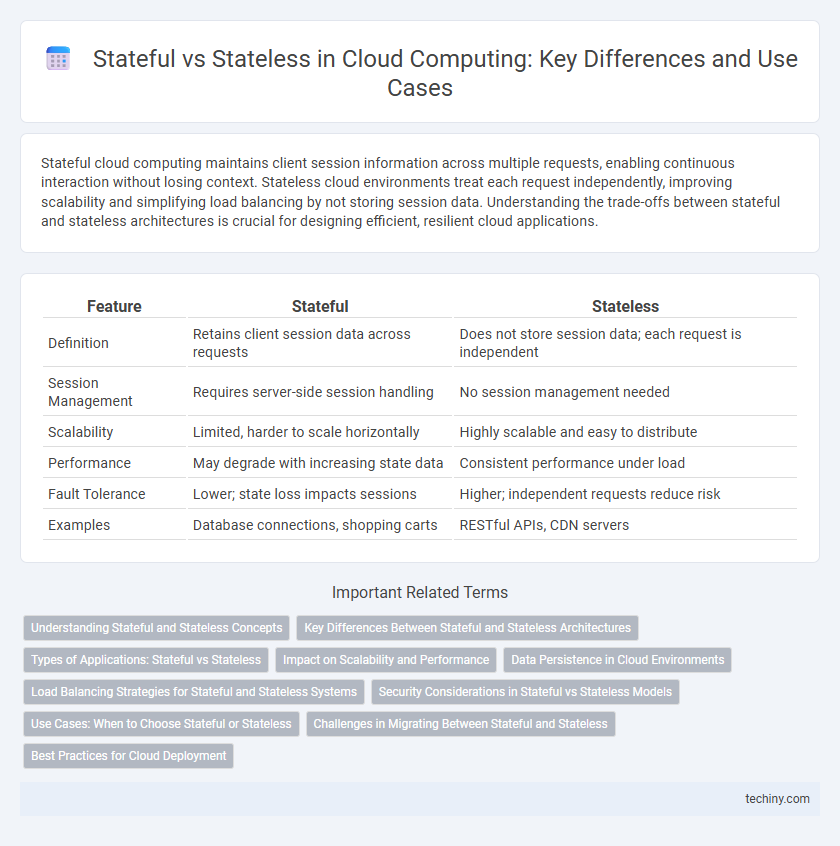Stateful cloud computing maintains client session information across multiple requests, enabling continuous interaction without losing context. Stateless cloud environments treat each request independently, improving scalability and simplifying load balancing by not storing session data. Understanding the trade-offs between stateful and stateless architectures is crucial for designing efficient, resilient cloud applications.
Table of Comparison
| Feature | Stateful | Stateless |
|---|---|---|
| Definition | Retains client session data across requests | Does not store session data; each request is independent |
| Session Management | Requires server-side session handling | No session management needed |
| Scalability | Limited, harder to scale horizontally | Highly scalable and easy to distribute |
| Performance | May degrade with increasing state data | Consistent performance under load |
| Fault Tolerance | Lower; state loss impacts sessions | Higher; independent requests reduce risk |
| Examples | Database connections, shopping carts | RESTful APIs, CDN servers |
Understanding Stateful and Stateless Concepts
Stateful systems maintain persistent information about client interactions, enabling personalized experiences and continuous sessions by tracking previous actions and data. Stateless systems do not retain any client context between requests, promoting scalability and simplicity by treating each interaction as independent. Understanding these concepts is crucial for designing cloud computing architectures that balance performance, reliability, and resource management.
Key Differences Between Stateful and Stateless Architectures
Stateful architectures maintain session information between client and server, enabling data persistence and continuity across multiple interactions, often used in applications like online banking or shopping carts. Stateless architectures treat each request as independent, with no stored context, enhancing scalability and reliability by simplifying load balancing and failure recovery, commonly seen in RESTful APIs. The key differences lie in data persistence, session handling, and resource management, impacting system design, performance, and scalability.
Types of Applications: Stateful vs Stateless
Stateful applications maintain persistent user sessions and store data across interactions, making them ideal for complex transactions like online banking or e-commerce platforms. Stateless applications, commonly used in RESTful APIs and microservices, do not retain session information between requests, enabling easier scaling and reduced server overhead. Understanding the distinction between stateful and stateless architectures is crucial for designing efficient cloud-native applications and optimizing resource allocation.
Impact on Scalability and Performance
Stateful architectures maintain session information across requests, which can hinder scalability by requiring session persistence and limiting load balancing flexibility. Stateless designs improve performance and scalability by treating each request independently, allowing easier distribution of workloads across servers. Cloud platforms leverage statelessness to optimize resource utilization and enhance fault tolerance during high demand.
Data Persistence in Cloud Environments
Stateful cloud computing architectures maintain data persistence by storing session information and application state across requests, enabling continuous user experiences and reliable data management. Stateless architectures, in contrast, do not retain session data between interactions, relying on external storage solutions like databases or distributed caches to ensure data persistence. Effective data persistence strategies in cloud environments involve combining stateful components with scalable, durable storage systems to balance performance and resilience.
Load Balancing Strategies for Stateful and Stateless Systems
Load balancing strategies for stateful systems prioritize maintaining session affinity or sticky sessions to ensure user-specific state data persists across requests, often using techniques like session replication or centralized session stores. Stateless systems allow more flexible load balancing methods such as round-robin or least connections, since no session data needs to be preserved between requests, enabling easier horizontal scaling and failover. Effective load balancers must tailor their approach to handle state management challenges in stateful architectures while leveraging the simplicity and scalability of stateless designs.
Security Considerations in Stateful vs Stateless Models
Stateful models in cloud computing maintain session information, increasing vulnerability to session hijacking and requiring robust encryption and secure token management to protect sensitive data. Stateless architectures reduce attack surfaces by avoiding server-side session storage, enabling easier horizontal scaling and minimizing risks associated with session persistence. Security considerations favor stateless designs for improved fault tolerance and resilience, but stateful applications demand advanced security protocols to safeguard ongoing interactions.
Use Cases: When to Choose Stateful or Stateless
Stateful architectures are ideal for applications requiring persistent user sessions, such as e-commerce platforms and online banking, where transaction history and user context must be maintained. Stateless designs suit microservices and serverless environments, enabling easy scaling and fault tolerance by treating each request independently without storing session data. Choosing between stateful and stateless depends on workload demands, consistency requirements, and the need for session persistence or rapid scalability.
Challenges in Migrating Between Stateful and Stateless
Migrating between stateful and stateless architectures presents challenges such as maintaining data consistency and session continuity during the transition, as stateful systems rely heavily on persistent storage and context. Ensuring seamless user experience requires complex synchronization mechanisms to transfer or replicate state information without causing interruptions or data loss. The complexity increases with distributed cloud environments where session handling and state management must adapt to stateless microservices or serverless models that emphasize scalability and fault tolerance.
Best Practices for Cloud Deployment
Stateful cloud deployments require persistent storage and session management to maintain user data continuity, making them ideal for applications needing data retention across sessions. Stateless architectures enhance scalability and fault tolerance by treating each request independently, allowing easy replication and load balancing across distributed cloud environments. Best practices recommend combining stateless microservices with external state stores like databases or caches to optimize performance, reliability, and scalability in cloud deployments.
Stateful vs Stateless Infographic

 techiny.com
techiny.com